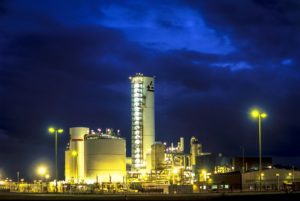How a modernization project increased a plant’s production efficiency by 20%
The Modicon PLC was a game changer for control system technology. It was designed in 1968 to be a simple replacement for hard wired relays. The goals were to:
- Shorten the time to market for new products
- Improve production profitability and reliability
- Make it easier to diagnose and maintain control systems
Looking back, it achieved all this, and more. This early digital technology not only made the engineering process more efficient, it also helped trouble shoot failures during production and freed up valuable production space formerly reserved for massive relay control cabinets.
All these factors combined to significantly boost operational productivity for the automaker.
How control system advances can translate to measurable production increases
Fifty years later, what’s changed? Modern control systems are still designed with all these goals in mind, but today’s state of the art approaches offer even more effective ways to improve efficiency in the areas of engineering, operations and maintenance.
Thanks to advances in technology, companies can now expect to achieve:
- Higher levels of overall efficiency
- Faster project delivery
- Return on investment sooner
In fact, following a modernization project our customers Casa Granado achieved a 15-20% increase in production efficiency, while Veolia Water saw a 15% annual energy savings and a 20% increase in production efficiency.
Today’s automation systems offer plant wide standardization
One of the biggest advantages for a modern plant is that you can manage several PLCs across the plant as one system. Just twenty years ago, to make plant-wide changes each PLC would need to be programmed individually. Today’s modern control systems allow multiple engineers to collaborate during design and provide a plant wide view of the process with enhanced lifecycle maintenance and diagnostics.
For instance, Veolia Water needed an automation system flexible and powerful enough for a wastewater treatment plant in a tunnel. With our distributed control system we were able to unify several control units into one central system, where operators manage a significant amount of information and diagnostics. As I mentioned, they saw a sharp increase in both energy efficiency and production efficiency. Like the original Modicon innovation, not only does standardization make the modernization process more efficient, it also makes operating and maintaining the plant more efficient.
 Bulk engineering helps reduce project delivery time
Bulk engineering helps reduce project delivery time
Another approach that increases engineering efficiency is the move towards object-based systems. Objects representing the Control, HMI and alarm functions of a particular asset can be deployed as many times as any given type of asset (e.g. a pump) is required by the process. This reduces design time and programming errors, drives plant wide standardization and ensures the right functionality is there at the right level of quality.
Object-based engineering also pays off when it comes to operational efficiency as lifecycle maintenance is much easier. The plant is built from a library of objects and any changes to one of these objects can be automatically deployed across the plant.
Other modern control system technologies that contributes to operational and maintenance efficiency are runtime navigation services and situational awareness, the latter of which I wrote about in my last blog “How to avoid information overload in your process control room”.
Automation systems have come a long way – and so have their business value
Our project with Casa Granado, Brazil’s oldest cosmetic maker, shows just how far Control systems have come in 50 years. As part of their goal to strengthen and expand the brand internationally, Casa Granado needed to address inefficiencies and increase production quality. With current control system technology both operators and maintenance staff are able to work more efficiently, allowing them to save repeatable processes and adjust quickly to accommodate changing market demands. It also helps them increase product quality throughout the process and improve productivity (by 15%) since less product is rejected.
While the main industrial business goals remain the same as when Casa Granado opened their first store over 100 years ago, 21st century systems can offer far more elegant and effective ways of meeting production quality and traceability targets. And this post only scratches the surface of what’s possible.
Learn more about the latest control system technology here.



